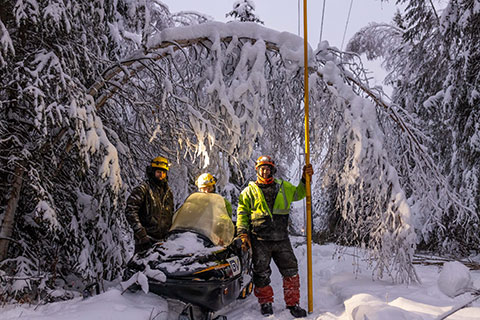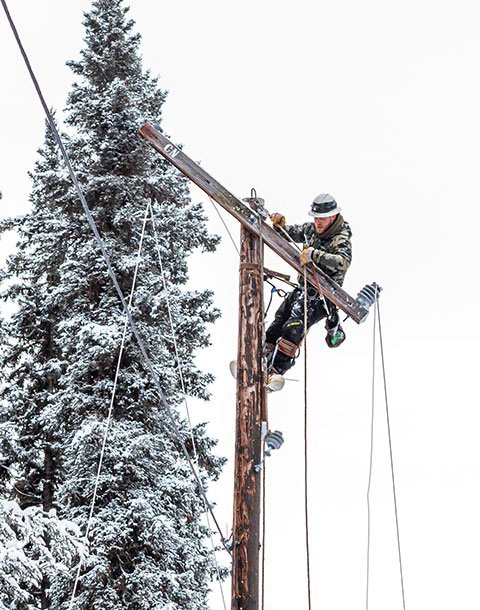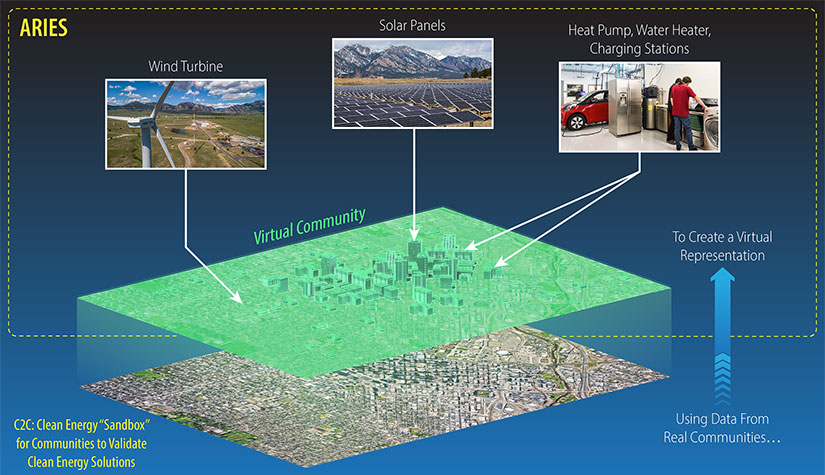NREL Supports Alaska Utility Amid Coal Plant Retirement Through Clean Energy to Communities Program
Jan. 17, 2023
As a partner in the U.S. Department of Energy's (DOE's) Clean Energy to Communities (C2C) program, NREL is supporting energy resilience for one Alaska utility using tools like the Simulation and Emulation for Advanced Systems (SEAS) software. Learn more in this blog.

In early December 2022, a snowstorm hit Fairbanks, Alaska, blanketing the city of around 32,000 people in 6 inches of snow and dumping even more on the surrounding hillsides. The trees got so heavy that they started leaning into power lines, triggering a series of outages that affected more than 7,000 homes and persisted for weeks. When the temperatures plunged soon after, hundreds of homes were still without power.
"It's 26 below zero, and our crew has spent the night on outage management," said John Burns, CEO of Golden Valley Electric Association (GVEA), the local utility that serves Fairbanks and other Interior Alaska communities.
GVEA's 6,000-mi2 service area includes hospitals, mines, and four critical military bases. When you're 350 mi from the nearest city, in a climate where cars won't start without being plugged in, having access to reliable power is critical. Managing a small electric grid in such a rugged environment is challenging and expensive, and GVEA members have some of the highest—and most volatile—energy costs in the nation. From June 2020 to June 2022, the fuel and purchase power cost per kilowatt-hour nearly doubled, hitting residents and businesses hard.

"If your cost of power changes on a quarterly basis, goes up, goes down, how do you plan? How do you have a business profile you can plan for?" Burns said.
That's why GVEA is working with NREL as part of the C2C program to figure out ways to make its power system more reliable and more affordable as it transitions to clean energy solutions.
"GVEA is an innovative utility with incredible staff. This project was designed to support GVEA in that innovation as it moves toward the future of affordable, resilient electricity in Interior Alaska," said Sherry Stout, NREL's State, Local, and Tribal laboratory program manager and one of the researchers who has worked on the project.
Transitioning From Coal to Clean Energy
GVEA generates 91% of its power from fossil fuels, which has brought high costs and high emissions. Moreover, GVEA relies on aging infrastructure. Through the C2C program, the utility has been working with the NREL team over the past year to create a detailed analysis of the current generation plan and evaluate the impact to the GVEA system of transitioning to clean energy solutions. Central to the plan is shutting down a 50-MW coal plant by 2025 and replacing it with three sources: new wind generation, new energy storage, and imports of additional power from Southcentral Alaska.
Using tools like the Simulation and Emulation for Advanced Systems (SEAS) software, NREL figured out how large-scale wind power could be added to the grid without affecting its performance. It helped the GVEA team assess different battery storage systems to replace its existing storage system, which—when it was installed 18 years ago—was the largest battery in the world and is now able to provide 46 MW for 5 min.
"Working in Fairbanks," said Jen King, senior research engineer at NREL, "has helped us understand how we can tailor the tools we have developed at NREL and the larger DOE lab complex to answer community-specific questions as well as derisk and accelerate an individual community's clean energy transition."

Finally, GVEA will work with the State of Alaska and other utilities to upgrade transmission lines that run 700 mi across the state to bring more energy from the Bradley Lake Project and Southcentral Alaska, which has access to wind, hydropower, and other clean energy sources.
"It is literally a 700-mi extension cord," Burns said. "Upgrading the transmission system will allow additional integration of renewables, it will allow diversification, it will allow redundancy and resiliency."
Thanks to GVEA's vision and support from NREL and DOE, the utility is poised to reduce its emissions while addressing affordability and reliability of GVEA's system while.
"We very much appreciate NREL's willingness to jump in with both feet and help us along the way," Burns said.
About the Clean Energy to Communities Program
Learn more about the C2C program and NREL's involvement.
Share

